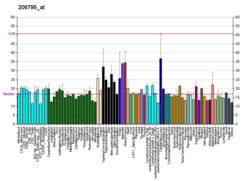Protease activated receptor 3 (PAR-3) also known as coagulation factor II receptor-like 2 (F2RL2) and thrombin receptor-like 2, is a protein that in humans is encoded by the F2RL2 gene.
Function
editCoagulation factor II (thrombin) receptor-like 2 (F2RL2) is a member of the large family of 7-transmembrane receptors that couple to G proteins. F2RL2 is also a member of the protease-activated receptor family and activated by thrombin. F2RL2 is activated by proteolytic cleavage of its extracellular amino terminus. The new amino terminus functions as a tethered ligand and activates the receptor. F2RL2 is a cofactor for F2RL3 activation by thrombin. It mediates thrombin-triggered phosphoinositide hydrolysis and is expressed in a variety of tissues.[5]
See also
editReferences
edit- ^ a b c GRCh38: Ensembl release 89: ENSG00000164220 – Ensembl, May 2017
- ^ a b c GRCm38: Ensembl release 89: ENSMUSG00000021675 – Ensembl, May 2017
- ^ "Human PubMed Reference:". National Center for Biotechnology Information, U.S. National Library of Medicine.
- ^ "Mouse PubMed Reference:". National Center for Biotechnology Information, U.S. National Library of Medicine.
- ^ "Entrez Gene: F2RL2 coagulation factor II (thrombin) receptor-like 2".
Further reading
edit- Hollenberg MD, Compton SJ (2002). "International Union of Pharmacology. XXVIII. Proteinase-activated receptors". Pharmacol. Rev. 54 (2): 203–17. doi:10.1124/pr.54.2.203. PMID 12037136. S2CID 3188040.
- Ishihara H, Connolly AJ, Zeng D, et al. (1997). "Protease-activated receptor 3 is a second thrombin receptor in humans". Nature. 386 (6624): 502–6. Bibcode:1997Natur.386..502I. doi:10.1038/386502a0. PMID 9087410. S2CID 4359291.
- Schmidt VA, Nierman WC, Maglott DR, et al. (1998). "The human proteinase-activated receptor-3 (PAR-3) gene. Identification within a Par gene cluster and characterization in vascular endothelial cells and platelets". J. Biol. Chem. 273 (24): 15061–8. doi:10.1074/jbc.273.24.15061. PMID 9614115.
- Xu WF, Andersen H, Whitmore TE, et al. (1998). "Cloning and characterization of human protease-activated receptor 4". Proc. Natl. Acad. Sci. U.S.A. 95 (12): 6642–6. Bibcode:1998PNAS...95.6642X. doi:10.1073/pnas.95.12.6642. PMC 22580. PMID 9618465.
- Guyonnet Dupérat V, Jacquelin B, Boisseau P, et al. (1998). "Protease-activated receptor genes are clustered on 5q13". Blood. 92 (1): 25–31. doi:10.1182/blood.V92.1.25.413k41_25_31. PMID 9639495.
- Kahn ML, Zheng YW, Huang W, et al. (1998). "A dual thrombin receptor system for platelet activation". Nature. 394 (6694): 690–4. Bibcode:1998Natur.394..690K. doi:10.1038/29325. PMID 9716134. S2CID 4408582.
- Kahn ML, Hammes SR, Botka C, Coughlin SR (1998). "Gene and locus structure and chromosomal localization of the protease-activated receptor gene family". J. Biol. Chem. 273 (36): 23290–6. doi:10.1074/jbc.273.36.23290. PMID 9722561.
- Kahn ML, Nakanishi-Matsui M, Shapiro MJ, et al. (1999). "Protease-activated receptors 1 and 4 mediate activation of human platelets by thrombin". J. Clin. Invest. 103 (6): 879–87. doi:10.1172/JCI6042. PMC 408153. PMID 10079109.
- Hauck RW, Schulz C, Schömig A, et al. (1999). "alpha-Thrombin stimulates contraction of human bronchial rings by activation of protease-activated receptors". Am. J. Physiol. 277 (1 Pt 1): L22–9. doi:10.1152/ajplung.1999.277.1.L22. PMID 10409227.
- Nakanishi-Matsui M, Zheng YW, Sulciner DJ, et al. (2000). "PAR3 is a cofactor for PAR4 activation by thrombin". Nature. 404 (6778): 609–13. Bibcode:2000Natur.404..609N. doi:10.1038/35007085. PMID 10766244. S2CID 4410800.
- O'Brien PJ, Prevost N, Molino M, et al. (2000). "Thrombin responses in human endothelial cells. Contributions from receptors other than PAR1 include the transactivation of PAR2 by thrombin-cleaved PAR1". J. Biol. Chem. 275 (18): 13502–9. doi:10.1074/jbc.275.18.13502. PMID 10788464.
- Cumashi A, Ansuini H, Celli N, et al. (2001). "Neutrophil proteases can inactivate human PAR3 and abolish the co-receptor function of PAR3 on murine platelets". Thromb. Haemost. 85 (3): 533–8. doi:10.1055/s-0037-1615617. PMID 11307827. S2CID 37320447.
- Sambrano GR, Weiss EJ, Zheng YW, et al. (2001). "Role of thrombin signalling in platelets in haemostasis and thrombosis". Nature. 413 (6851): 74–8. Bibcode:2001Natur.413...74S. doi:10.1038/35092573. PMID 11544528. S2CID 4327515.
- Miike S, McWilliam AS, Kita H (2002). "Trypsin induces activation and inflammatory mediator release from human eosinophils through protease-activated receptor-2". J. Immunol. 167 (11): 6615–22. doi:10.4049/jimmunol.167.11.6615. PMID 11714832.
- Strausberg RL, Feingold EA, Grouse LH, et al. (2003). "Generation and initial analysis of more than 15,000 full-length human and mouse cDNA sequences". Proc. Natl. Acad. Sci. U.S.A. 99 (26): 16899–903. Bibcode:2002PNAS...9916899M. doi:10.1073/pnas.242603899. PMC 139241. PMID 12477932.
- Even-Ram SC, Grisaru-Granovsky S, Pruss D, et al. (2003). "The pattern of expression of protease-activated receptors (PARs) during early trophoblast development". J. Pathol. 200 (1): 47–52. doi:10.1002/path.1338. PMID 12692840. S2CID 23097607.
- Owen WG (2003). "PAR-3 is a low-affinity substrate, high affinity effector of thrombin". Biochem. Biophys. Res. Commun. 305 (1): 166–8. doi:10.1016/S0006-291X(03)00732-0. PMID 12732212.
- Tanaka N, Morita T, Nezu A, et al. (2003). "Thrombin-induced Ca2+ mobilization in human gingival fibroblasts is mediated by protease-activated receptor-1 (PAR-1)". Life Sci. 73 (3): 301–10. doi:10.1016/S0024-3205(03)00269-8. PMID 12757837.
This article incorporates text from the United States National Library of Medicine, which is in the public domain.




